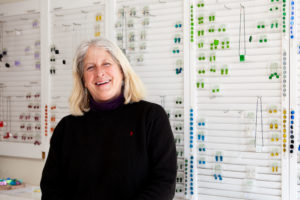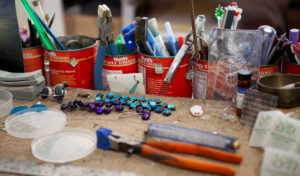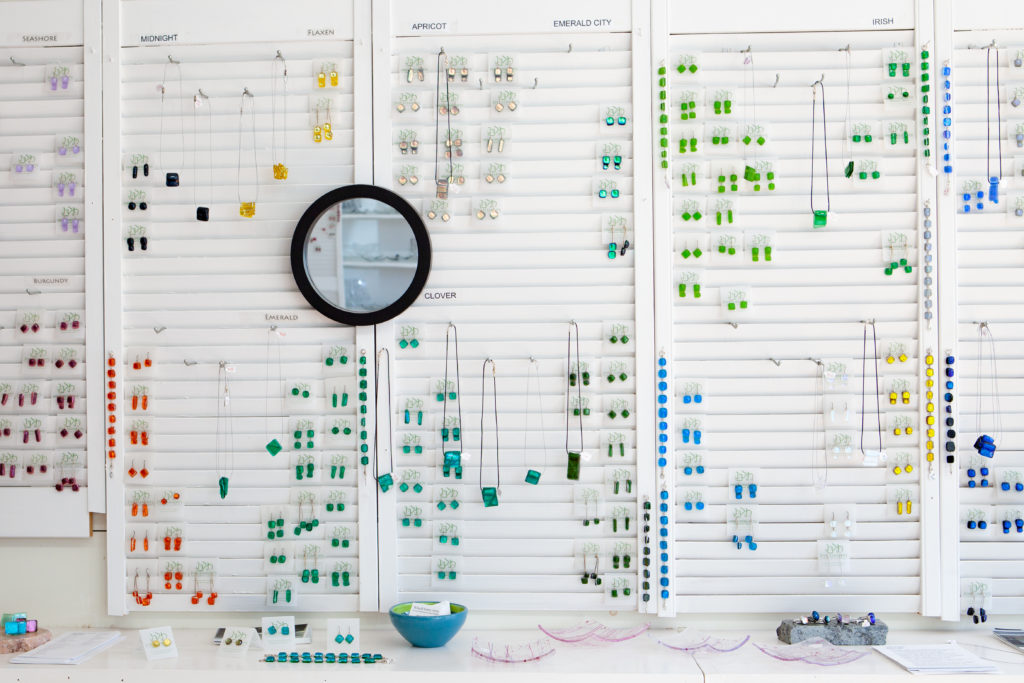Part of our ongoing series of Archipelago artist profiles, this profile looks at Archipelago artist Alison Thibault of WindHorse Arts on Vinalhaven. The Island Institute’s Lisa Millette first traveled to the island in early March, before Governor Mills issued a statewide lockdown, to connect with Alison and talk about her process for creating her colorful glass jewelry. Since then, they also reconnected to talk about how her business and her work were impacted by the pandemic.

Continuing with the theme of celebrating Archipelago’s 20+ years of supporting Maine artists and makers, today we meet a maker from one of Maine’s islands, Vinalhaven, whose community extends far beyond the island itself. Through her one-woman business WindHorse Arts, Alison Thibault, creates beautiful glass jewelry that attracts customers from near and far and connects them to the Maine island. Alison’s work has such a unique calling card that people will recognize a Windhorse Arts piece everywhere from a grocery store on the mainland to an airport in Australia. Her customers are connected not only through the vibrant colored-glass jewelry itself, but also through their shared relationship to the island.
I lucked out and caught the ferry out of Rockland on a deliciously sunny day in early March 2020 before the coronavirus pandemic had spread to the Northeastern most corner of our country. Alison greeted me at the dock, and as it was my first time on-island, gave me a quick tour of downtown. We passed by Island Spirits, a lovingly curated wine shop and popped into the Good Things Coffee House. While in the coffee house, Alison caught up with some neighbors, while I ordered a cup of tea.
The last stop of the tour was our destination: Alison’s storefront/studio. Gigi, her rescue dog, met us excitedly upon arrival. The sun poured in through the large, south-facing glass windows of her shop and filled the space with warmth. The light reflected and bounced off of a rainbow of her fused glass jewelry hanging from the walls of the shop.
A one-woman show, Alison runs the retail shop sometimes simultaneously to working in her studio at the rear of the space. Living in a small, island community, the open shop invites not only customers but community members, including the town manager, who will stop in to ask questions about an island decision or elicit feedback on a project. Having a storefront downtown, especially one filled with light and color, contributes to the vibrancy of the area; reciprocally, the colors and imagery of the island inspire Alison’s work.
Alison came to making fused glass jewelry rather serendipitously. Over 20 years ago, an earring gifted from her mother went missing and Alison was faced with a choice—buy a new pair or try and replicate the missing earring. Alison chose the latter, setting off the chain of events which led to her taking on jewelry making full-time. Said Alison, “Inspired to make a match for the remaining favorite earring, I learned to fuse glass at a moment when I was seeking a new way to live and work I wouldn’t want to retire from. When people started asking to buy the jewelry right off my body, I listened.”
Learning how to make fused-glass jewelry at the turn of the millennia was challenging. Without the digital wealth of knowledge now available at our fingertips, Alison largely learned through books and experimentation. Some of those experiments included learning how to keep the cut glass stacked neatly as it is placed in the kiln, what color and texture combinations work or do not, and a variety of kiln successes and mishaps. A systems person, Alison started making earrings with either black or clear backgrounds. You see, her earrings are three layers, and with three layers of assorted colors and qualities of glass—smooth, textured, dichromatic, etc.—the possibilities are endless. As her color combinations grow, so does her recordkeeping. Each glass color receives a number, so that the final fused glass combination has a unique number of its own, allowing Alison to recreate color and texture combinations by knowing which glass was the bottom, middle, and top layer.
“Inspired to make a match for the remaining favorite earring, I learned to fuse glass at a moment when I was seeking a new way to live and work I wouldn’t want to retire from. When people started asking to buy the jewelry right off my body, I listened.” – Alison Thibault
With endless combinations, Alison experiments with new ones each year, while keeping a steady supply of earrings, pendants, and bracelets in her core tried-and-true collection of colors. These combinations are given names, often island-inspired, by Alison or community youth. However, Alison knows her glass the best by the numbers, largely because the color and look of the glass is unrecognizable as a final product, transformed from its original raw form once it comes out of the 1500-degree kiln.
Not only are her glass combinations recorded, but every customer order is as well. Alison has an extensive card file listing customer names, the date of their visit, and their purchase, allowing for customers to call her and order a matching bracelet for the earrings they purchased their spouse three summers previous. Talk about customer service!

Part of Vinalhaven’s downtown fabric, Alison has a visible space to share and sell her work, a testament that one can do what they love while making a living. She hopes that it inspires others with similar visions to do the same. The shop is closed when detailed parts of the glass fusing process require her full attention. However, this dynamic will soon change as Alison is building a studio near her home—not only to provide her with a space to focus on her work away from downtown Vinalhaven, but to also host glass-fusing workshops for the year-round and seasonal community.
Smaller shifts to her work have also happened in response to the pandemic. The Island Institute’s Small Business team ran all of its programs virtually, and this allowed her to participate much more. As an island resident, attending in-person workshops and conferences are time commitments and can sometimes be costly with the ferry ride, overnight lodging, and food taken into consideration. These workshops allowed her to think about her business in alternative ways, including reevaluating what is important in her operations. “[The Business for Purpose and Profit workshops] brought me back to beginning, and why I’m doing what I’m doing to create the life I wanted,” said Alison.
She expressed great appreciation for the Commercial Currents podcast that the Island Institute ran through 2020, which gave small island and coastal business owners the opportunity to share their stories and navigate the challenges of the pandemic together. It also provided access to resources available to help small business owners during this time, including financial support from the Island Institute’s Business Resilience Grants, provided through the Tom Glenn Community Impact Fund. The pandemic has also nudged additional shifts in Alison’s business. To supplement the income not coming in from summer sales, she decided to assist artists in setting up their own websites for online sales. And as it did for many of us, the pandemic also highlighted the importance of focusing on other areas of her life, such as taking the time to catch up with friends and getting outside more.
Alison is a strong advocate for finding the path that feeds you—a path where you can wake up every day and delight in your work. She shares that there hasn’t been a single day is these past 20 years where she’s woken up and bemoaned going to work. That isn’t to say the work has been easy, especially through this past year. However, the fulfillment is worth the trials along the way.
About Archipelago
Archipelago, the Island Institute’s store and gallery, showcases Maine artists and makers whose work reflects the beauty and endurance of Maine’s islands and coast. A key element of the Institute’s small business program, Archipelago has provided over $2.5 million in income to artists and makers and advanced the careers of more than 1,500 Maine residents since opening in 2000. In addition, Archipelago staff spend over 400 hours a year mentoring artists to help increase their skills and knowledge for running arts-based small businesses. Learn more here.


